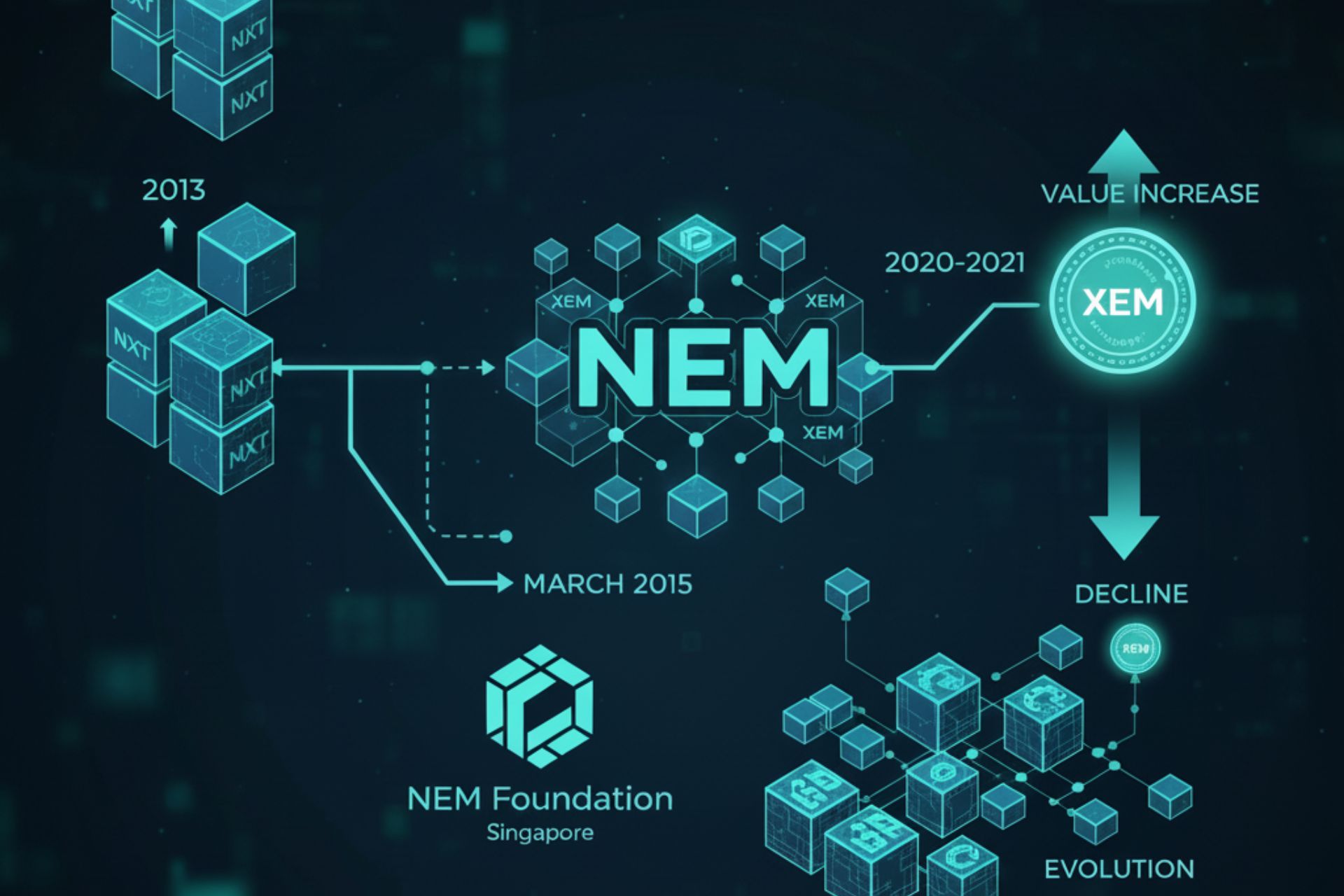What is NEM? Everything about this hybrid blockchain and its cryptocurrency XEM

Table of Contents
ToggleCryptocurrency projects vary considerably, each with a specific goal that defines the value of its cryptocurrency. In this article, a particular project will be explained: NEM (New Economy Movement).
According to its team, NEM aims to “serve enterprise blockchain markets and provide extreme versatility in serving diverse markets”.
What is NEM?
NEM (New Economy Movement) seeks to deploy a more advanced blockchain, which it calls Smart Asset Blockchain. This technology platform, written in Java, primarily aims to offer an efficient and economical way to manage assets and data. Its native currency, also called NEM (XEM), is fundamental to its ecosystem.

Like Bitcoin, NEM operates with a network of independent and distributed nodes that process and record transactions in a public ledger. NEM’s utility and focus have positioned it among the cryptocurrency projects with the highest market capitalization.
How does NEM work?
NEM performs its tasks by integrating a variety of new technologies. This versatile blockchain introduces a new consensus mechanism to the market: Proof of Importance (PoI). PoI differs from other consensus mechanisms, such as Bitcoin’s PoW, in several aspects. Primarily, in a PoI mechanism, the time and amount someone has invested in the NEM network are taken into account.
What is Proof of Importance (PoI)?
NEM’s PoI worked similarly to many PoS (Proof of Stake) systems but with different requirements. Additionally, NEM’s PoI rewarded users who transacted with other users on the network. Conducting more transactions above a minimum amount also increased a participant’s PoI score, granting them more opportunities to earn a reward.

To prevent misuse through fictitious transactions among a group of users, the NEM network also considered the net transaction amount to improve the PoI score.
How are blocks generated and transactions validated?
In NEM, block generation and transaction validation occur through a process called harvesting. It is a process by which blocks are generated, and transaction fees are paid as rewards for validating transactions. The PoI algorithm determines who is responsible for harvesting/generating a new transaction block and being rewarded for it.
What role does XEM play in the network?
XEM is the native currency of the public NEM blockchain, launched in 2018. It is used to pay for transactions on the public NEM blockchain. Likewise, it is used to incentivize the public node network to process and record transactions for participants.

Smart Assets and mosaics
NEM’s primary function is the implementation of what they call the Smart Assets System, which provides businesses with tools to manage their assets through a customizable blockchain, managed via API calls.
Smart Assets can be divided into several components, one of which is mosaics, which are the network’s assets and reside at addresses. Any asset, whether digital or physical, can be linked to a mosaic. These have customizable names, descriptions, visibility, quantities, and transferability restrictions if needed. They could represent digital currencies, other currencies, travel miles points, company shares, deeds, digital signatures, among others.
Who founded NEM?
NEM was originally created by three developers known by their pseudonyms on the Bitcointalk.org forum: Jaguar0625, BloodyRookie, and gimre. From its beginnings in 2014-2015, NEM evolved from a personal project of three programmers to a large ecosystem comprising several platforms.

Specifically, NEM’s founders are Lon Wong, Jeff McDonald, and other members who contributed to the platform’s development. Lon Wong, who was president of the NEM.io Foundation, also founded ProximaX Ltd. Besides Lon Wong and Jeff McDonald, other founding members include Erik Van Himbergen and Leon Yeoh.
Origins of NEM in 2015
NEM evolved in March 2015 as a forked version of NXT, another popular blockchain-based virtual currency and payment network platform. It was operated by the NEM Foundation, a non-profit organization based in Singapore. After the hard fork, NEM developers created a codebase to improve NEM and make it faster and more scalable. Thus, a new NEM cryptocurrency platform emerged, completely different from the original NXT.
NEM had its own cryptocurrency, called XEM. Although XEM was not accepted by merchants as a payment method like Bitcoin, its value increased between 2020 and 2021 until its lack of acceptance and market interest caused a decline.
NEM Foundation and its evolution
The NEM Foundation, registered in Singapore, is an international organization that oversees the promotion and development of NEM’s highly skilled blockchain technology project, managing the platform’s development and promotion.

What type of governance does NEM have?
NEM uses a consensus mechanism optimally suited to a decentralized governance model. Any XEM holder can vote to elect Council members and democratically propose who decides. In any case, the ease of voting in elections can be verified.
Decision-making mechanism
NEM’s decision-making mechanism is based on a combination of delegated consensus and on-chain voting. This allows XEM token holders, NEM’s native cryptocurrency, to participate in the platform’s governance. Essentially, this system seeks to balance decentralization and efficiency, enabling democratic and participatory decision-making while ensuring the network’s security and stability.
Recent changes with Symbol (its evolution)
NEM has evolved into Symbol (XYM), a new blockchain focused on the enterprise sphere, launched in March 2021. Symbol coexisted with the original NEM blockchain (XEM) and offers solutions for data management, logistics, among others.
- NEM 2.0 / Symbol: Symbol is an upgrade of the NEM platform, also known as NEM 2.0.
- Symbolis designed to support businesses in diverse areas.
- The original NEM blockchain continues to operate, while Symbol offers a new layer for enterprise applications.
- Symbol uses a PoS+ consensus algorithm, an enhanced version of the Proof-of-Stake consensus mechanism.
NEM’s Blockchain: NIS1 and its evolution with Symbol
NEM’s Symbol is based on advanced security features derived from its first blockchain, known as NIS1. The new blockchain runs separately from the original blockchain, which will continue to operate.

Additionally, the Symbol ecosystem offers a hardware wallet that supports offline signatures, along with on-chain multi-signature support, granting it high operational security levels.
Differences between NEM and Symbol
NEM and Symbol are two distinct blockchains; below are their key differences:
- NEM used PoI, while Symbol uses PoS+.
- NEM focused on a general community and applications, while Symbol is geared toward enterprises and complex use cases.
- Symbol is considered an upgrade of NEM with a more flexible and scalable architecture.
What advantages does NEM offer over other blockchains?
NEM offers several advantages over other blockchains, highlighting its focus on simplicity, ease of use, transaction speed, and its consensus algorithm, Proof of Importance (PoI).
Additionally, NEM enables the creation of smart assets, facilitates multi-signature transactions for enhanced security, and emphasizes energy efficiency.

Use cases in real businesses
NEM partnered with the Israeli-Lithuanian telecommunications company FIX Network to enhance security and protect cell phone users’ data and address SIM swapping issues.
On the other hand, the Chinese tech giant Tencent has explored using NEM for supply chain management applications, leveraging the platform’s transparency and traceability.
Market capitalization (Market Cap) of NEM
As of July 2, 2025, the global cryptocurrency market cap is $27.75M with a +4.17% change in the last 24 hours. The current price of XEM is $0.003122, with a 24-hour trading volume of $7.85M. XEM is +6.22% in the last 24 hours, with a circulating supply of 9.00 billion XEM coins.

It reached a 24-hour high of $0.00316929 recorded on Jul 2, 2025, and its 24-hour low so far is $0.00250354, recorded on Jul 2, 2025.
Historical price evolution of XEM
XEM’s historical price evolution has experienced significant fluctuations since its launch. Its all-time high (ATH) of $1.87 was recorded on January 6, 2018. And an all-time low (ATL) of $0.00008482, recorded on September 4, 2015. Currently, the price has declined both in the last 24 hours and the last 7 days, with -5.26% and -28.68% respectively.
Comparison with similar cryptocurrencies
Both NEM and other cryptocurrencies operate within a generic technology called Blockchain. However, NEM stands out in the cryptocurrency world by prioritizing simplicity and ease of use.
Unlike Bitcoin, which relies on intensive Proof of Work (PoW), NEM employs Proof of Importance (PoI). Beyond value transfer, NEM enables the registration of smart assets, message sending, and on-platform voting.
- NEM vs. Bitcoin: While Bitcoin focuses on value transfer and faces scalability challenges with high energy consumption (PoW), NEM offers broader functionalities and seeks greater transaction efficiency thanks to its PoI.
- NEM vs. Ethereum: Though Ethereum leads in complex Smart Contracts and has a vast development ecosystem, it has faced scalability and speed issues. NEM, meanwhile, offers analogous functionalities through mosaics and namespaces, aiming for greater transaction efficiency with its PoI algorithm, although its development community is smaller.

Factors driving its price
Factors affecting XEM’s price are diverse and complex, including supply and demand, news events, adoption and development, and general cryptocurrency market trends.
Current situation and expectations
NEM offers an impressive system that promises to be a key player in the future blockchain-driven economy. Its development ease, flexibility, and unique PoI system make NEM a highly attractive platform for any developer or business seeking to build a blockchain solution.
Over time, increasingly interesting projects based on NEM are expected to emerge.
As Lon Wong states:
«With its focus on simplicity and Proof of Importance, NEM lays the foundation for a future where active community participation drives innovation. Interesting projects are flourishing, and as history has taught us, what seems like a seed today can become a forest tomorrow».




